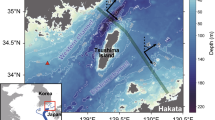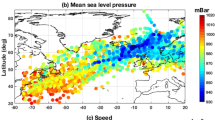Abstract
ENSO events are the most important interannual phenomena impacting climate and weather in South America and have been studied for a long time. Most studies gave special focus on its warm phase (El Niño events) during the austral summer months. However, it is not yet conclusive how the teleconnection patterns are modified according to the different intensities of ENSO events in different seasons and consequently impact South America. Therefore, this study aims to investigate how the different phases, intensities, and seasons of the ENSO events modulate the Stationary Rossby Waves that impact South America. For this, we developed a free and open-source tool called raytracing. The distribution of the SST anomalies influences ENSO intensity. When SST anomalies are higher and spread along the Equatorial Pacific Ocean, ENSO tends to be stronger. This has an impact on the convective source intensity and shapes leading to different Rossby wave sources. Weak ENSO events drive weak anomaly precipitation over South America, mainly in the southeast region. Stationary Rossby waves starting positions are slightly closer to the equator during El Niño over downstream crests/upstream troughs. During La Niña events, they are positioned poleward over downstream troughs/upstream crests. Stationary wavenumbers \({K}_{s}\) = 2 and 3 are predominant over South America during El Niño events and DJF La Niña events, while \({K}_{s}\) = 2 are predominant in the remaining La Niña events. The wave shape and amplitudes are almost constant during summer events independent of the ENSO intensity, configuring the robustness of the precipitation anomaly patterns over South America. However, in the other seasons, those wave features vary largely, influencing the position and signal of the precipitation anomalies over South America. As a general rule, positive precipitation anomalies regions are associated with a downstream crest and upstream trough in both ENSO phases. While downstream troughs/upstream crests are associated with negative precipitation impacts.













Similar content being viewed by others
Data Availability
The datasets generated during and/or analyzed during the current study are not publicly available due to their large volume but are available from the corresponding author upon reasonable request.
Notes
As defined in the present study at Sect. 2.2.
References
Aceituno P (1988) On the functioning of the Southern Oscillation in the South American sector. Part I: surface climate. Mon Weather Rev 116:505–524
Adler R, et al (2016) Global Precipitation Climatology Project (GPCP) Climate Data Record (CDR), Version 2.3 (Monthly). https://doi.org/10.7289/V56971M6
Adler R, Coauthors (2018) The global precipitation Climatology Project (GPCP) monthly analysis (New Version 2.3) and a review of 2017 global precipitation. Atmosphere 9:138. https://doi.org/10.3390/atmos9040138
Ambrizzi T, Hoskins BJ, Hsu HH (1995) Rossby wave propagation and teleconnection patterns in the austral winter. J Atmos Sci 52(21):3661–3672
Braga HA, Ambrizzi T, Hall N (2022) Relationship between interhemispheric Rossby wave propagation and South Atlantic convergence zone during La Niña years. Int J Climatol. https://doi.org/10.1002/joc.7755. (Accepted for publication)
Cai W, McPhaden MJ, Grimm AM et al (2020) Climate impacts of the El Niño-Southern Oscillation on South America. Nat Rev Earth Environ 1:215–231
Carvalho LMV, Jones C, Ambrizzi T (2005) Opposite phases of the Antarctic Oscillation and relationships with intraseasonal to interannual activity in the tropics during the Austral summer. J Clim 18:702–718
Coelho CA, de Oliveira CP, Ambrizzi T, Reboita MS, Carpenedo CB, Campos JLPS, Rehbein A (2016) The 2014 southeast Brazil austral summer drought: regional scale mechanisms and teleconnections. Clim Dyn 46(11):3737–3752
Core Team R (2021) R: A language and environment for statistical computing
Fogt RL, Bromwich DH, Hines KM (2011) Understanding the SAM influence on the South Pacific ENSO teleconnection. Clim Dyn 36:1555–1576
Grimm AM, Ferraz SET, Gomes J (1998) Precipitation anomalies in southern Brazil associated with El Niño and La Niña events. J Clim 11:2863–2880
Grimm AM, Barros VR, Doyle ME (2000) Climate variability in southern South America associated with El Niño and La Niña events. J Clim 13:35–58
Hoskins BJ, Ambrizzi T (1993) Rossby wave propagation on a realistic longitudinaly varying flow. J Atmos Sci 50:1661–1671
Hoskins BJ, Karoly DJ (1981) The steady linear response of a spherical atmosphere to thermal and orographic forcing. J Atmos Sci 38(6):1179–1196
Hsu HH, Lin SH (1992) Global teleconnections in the 250-mb streamfunction field during the Northern Hemisphere winter. Mon Weather Rev 120(7):1169–1190
Huang B, Thorne PW, Banzon VF, Boyer T, Chepurin G, Lawrimore JH, Menne MJ, Smith TM, Vose RS, Zhang H (2017) Extended reconstructed Sea Surface temperature, Version 5 (ERSSTv5): upgrades, validations, and Intercomparisons. J Clim 30(20):8179–8205
Kanamitsu M, Ebisuzaki W, Woollen J, Yang S-K, Hnilo JJ, Fiorino M, Potter GL. NCEP-DOE AMIP-II Reanalysis (R-2). 1631–1643, Nov 2002. Bulletin of the American Meteorological Society
Kousky VE, Ropelewski CF (1989) Extremes in the Southern Oscillation and their relationship to precipitation anomalies with emphasis on the South American region. Rev Bras Meteorol 4:351–363
Kousky VE, Kayano MT, Cavalcanti IFA (1984) A review of the Southern Oscillation: oceanic–atmospheric circulation changes and related rainfall anomalies. Tellus 36A:490–504
Li RKK et al (2020) Effect of the North Pacific tropospheric waveguide on the fidelity of model El Niño teleconnections. J Clim 3312:5223–5237
Liebmann B, Smith CA (1996) Description of a complete (interpolated) outgoing Longwave Radiation dataset. Bull Am Meteorol Soc 77:1275–1277
Magaña V, Ambrizzi T (2005) Dynamics of subtropical vertical motions over the Americas during El Niño boreal winters. Atmósfera 18:211–233
Pohl B, Matthews AJ (2007) Observed changes in the lifetime and amplitude of the Madden–Julian Oscillation associated with interannual ENSO sea surface temperature anomalies. J Clim 20:2659–2674
Reboita MS, Ambrizzi T, Rocha RP (2009) Relationship between the Southern Annular Mode and Southern Hemisphere atmospheric systems. Rev Bras Meteorol 24:48–55
Reboita MS, Ambrizzi T, Crespo NM, Dutra LMM, Ferreira GWDS, Rehbein A, Souza CAD (2021) Impacts of teleconnection patterns on South America climate. Ann N Y Acad Sci 1504(1):116–153
Rehbein A, Ambrizzi T, Ibarra-Espinosa S, Dutra L (2022) raytracing: an R package for identification and tracking the atmospheric Rossby waves. R package version 0.6.0, https://github.com/salvatirehbein/raytracing, doi: https://doi.org/10.5281/zenodo.4390985
Reynolds RW, Rayner NA, Smith TM, Stokes DC, Wang W (2002) An improved in situ and satellite SST analysis for climate. J Clim 15:1609–1625
Ropelewski CF, Halpert MS (1987) Global and regional scale precipitation associated with El Niño/Southern Oscillation. Mon Weather Rev 115:1606–1626
Sardeshmukh PD, Hoskins BJ (1988) The generation of global rotational flow by steady idealized tropical divergence. J Atmos Sci 45(7):1228–1251
Scott Yiu YY, Maycock AC (2019) On the seasonality of the El Niño teleconnection to the Amundsen Sea region. J Clim 3215:4829–4845
Souza EB, Kayano MT, Tota J et al (2000) On the influences of the El Niño, La Niña and Atlantic dipole pattern on the amazonian rainfall during 1960–1998. Acta Amaz 30:305–318
Wang G, Cai W (2013) Climate-change impact on the 20th-century relationship between the Southern Annular Mode and global mean temperature. Sci Rep 3:2039
Yang G-Y, Hoskins BJ (1996) Propagation of Rossby waves of nonzero frequency. J Atmos Sci 53:2365–2378
Acknowledgements
AR was supported by Fundação de Amparo à Pesquisa do Estado de São Paulo (FAPESP) Grants 2016/10557-0, 2018/16217-2, and 2021/07992-5. TA was partially funded by the National Institute of Science and Technology for Climate Change Phase 2 under CNPq, grant number 465501/2014-1; Fundação de Amparo à Pesquisa do Estado de São Paulo (FAPESP) grant numbers 2014/50848-9 and 2017/09659-6. TA also had partial support from CNPq 301397/2019-8.
Funding
Author A.R. has received research support from Fundação de Amparo à Pesquisa do Estado de São Paulo (FAPESP) (Grants number 2016/10557-0, 2018/16217-2, and 2021/07992-5). TA was partially funded by the National Institute of Science and Technology for Climate Change Phase 2 under CNPq, Grant number 465501/2014-1; Fundação de Amparo à Pesquisa do Estado de São Paulo (FAPESP) grant numbers 2014/50848-9 and 2017/09659-6. TA also had partial support from CNPq 301397/2019-8.
Author information
Authors and Affiliations
Contributions
All authors contributed to the study’s conception, design, and analysis. Material preparation and data collection were performed by AR. All authors read and approved the final manuscript.
Corresponding author
Ethics declarations
Conflict of interests
The authors have no financial or non-financial interests to disclose.
Ethics approval and consent to participate
Not applicable.
Consent for publication
Not applicable.
Additional information
Publisher’s Note
Springer Nature remains neutral with regard to jurisdictional claims in published maps and institutional affiliations.
Electronic supplementary material
Below is the link to the electronic supplementary material.
Rights and permissions
Springer Nature or its licensor (e.g. a society or other partner) holds exclusive rights to this article under a publishing agreement with the author(s) or other rightsholder(s); author self-archiving of the accepted manuscript version of this article is solely governed by the terms of such publishing agreement and applicable law.
About this article
Cite this article
Rehbein, A., Ambrizzi, T. ENSO teleconnections pathways in South America. Clim Dyn 61, 1277–1292 (2023). https://doi.org/10.1007/s00382-022-06624-3
Received:
Accepted:
Published:
Issue Date:
DOI: https://doi.org/10.1007/s00382-022-06624-3




